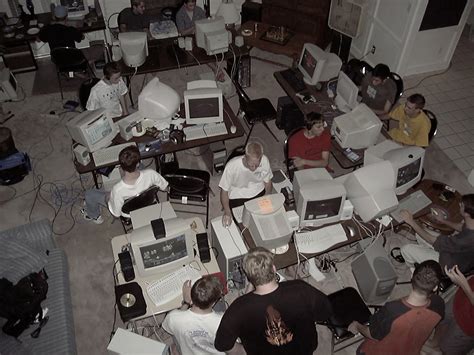The concept of a LAN (Local Area Network) party has always held a peculiar charm in the tech community, representing more than just a gathering for gaming. It was a fusion of social interaction, technological challenge, and collective endeavor. The golden days when people lugged their cumbersome CRT monitors and tangled nests of cables into a friend’s basement are etched in the minds of those who participated. These parties were not solely about who had the fastest reflexes in a game of Doom or Counter-Strike, but about the shared act of troubleshooting network glitches at 3 AM, and the communal joy of finally getting a game to run after hours of effort.
The sociocultural impact of LAN parties went beyond mere gaming. They fostered a sense of community and belonging that seems somewhat displaced in today’s gaming scenarios, where online multiplayer experiences often lack interpersonal interaction. Participants of LAN parties often formed lasting friendships, with their shared experiences extending into lifelong collaborations or mentorships in technology and gaming. This was a place where people could connect over shared struggles, like configuring drivers or dealing with hardware failures, all contributing to a tangible camaraderie that many feel is absent in today’s virtual communities.
However, the rise of high-speed internet and sophisticated online gaming platforms began to render the traditional LAN party obsolete. Gamers discovered the convenience of connecting with friends and strangers alike from the comfort of their own homes, without the physical and logistical challenges posed by LAN gatherings. This shift was also influenced by the evolution of gaming consoles and mobile gaming, which brought new ways to connect and play but lacked the same interactive richness and cooperative troubleshooting that characterized LAN parties.
Despite their decline, LAN parties have not disappeared entirely. There are still enthusiasts who appreciate the nostalgia and unique interaction that a LAN event facilitates. Certain games and communities, often revolving around classic games, continue to organize such events, though they are now more the exception than the norm. These gatherings serve not only as a nod to the past but also as a counter-movement against the increasingly solitary aspects of modern gaming.
Analyzing the broader implications, LAN parties helped democratize access to technology and gaming. They were inclusive, bringing together individuals regardless of their socioeconomic status. For many, these were the opportunities to engage with technology they could not afford privately, sharing resources and knowledge in a way that is rare today. This aspect contributed significantly to the spread of technological proficiency and enthusiasm among a whole generation.
Moreover, the decline of LAN parties points to broader societal shifts towards more individualistic and less community-oriented forms of entertainment. The transition from collective social gatherings to individual streaming has implications for social cohesion and collective problem-solving. LAN parties were not only about gaming; they involved collective strategizing, sharing, and personal interaction, elements that are increasingly mediated by digital interfaces and individualized by algorithms today.
What remains clear is that while technology will continue to evolve, the human need for connection and shared experiences remains constant. Whether through digital means or in face-to-face settings, creating opportunities for meaningful interactions is crucial. For those who lived through the era of LAN parties, they represent a cherished intersection of technology, play, and community that continues to impact how we think about gaming and social interaction in the digital age.


Leave a Reply